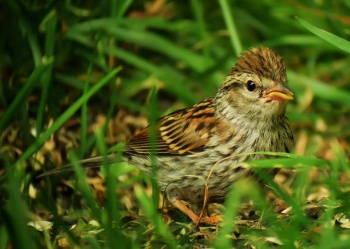- Spizella passerina
Identification
12–14 cm (5.5 ins)
In breeding plumage quite unique with a solid chestnut cap and black stripe through the eye, with the rest of the sides of the head and undersides an unmarked gray.
In juvenile plumage it has finely streaked underparts, and usually lacks the chestnut crown of an adult.
Distribution
Chipping sparrow is distributed from Alaska to eastern Canada through the USA and Mexico to Nicaragua.
Taxonomy
Subspecies
Five subspecies are recognized[1]:
- S. p. arizonae:
- S. p. passerina:
- South-eastern Canada to southern Texas and South Carolina; winters to north-eastern Mexico
- S. p. atremaeus:
- Mexico (Sierra Madre Occidental to pine belt of Nuevo León)
- S. p. mexicana:
- S. p. pinetorum:
Some authorities additionally recognize boreophilae.
Habitat
Woodlands, farmlands, urban districts and suburbs.
Behaviour
Diet
The diet includes seeds, insects and small fruits.
Breeding
It weaves a cup nest from grass and roots. The clutch consists of 2-7 pale blue eggs with dark blotches which are incubated for 10-15 days.
Vocalisation
Recording by eiguoc, Scarborough, Ontario

Photo © by Stanley Jones
Lick Creek Park, southeast College Station, Brazos County, Texas, USA, January-2019
References
- Clements, J. F., T. S. Schulenberg, M. J. Iliff, S. M. Billerman, T. A. Fredericks, B. L. Sullivan, and C. L. Wood. 2019. The eBird/Clements Checklist of Birds of the World: v2019. Downloaded from http://www.birds.cornell.edu/clementschecklist/download/
- All About Birds
Recommended Citation
- BirdForum Opus contributors. (2025) Chipping Sparrow. In: BirdForum, the forum for wild birds and birding. Retrieved 4 May 2025 from https://www.birdforum.net/opus/Chipping_Sparrow
External Links
GSearch checked for 2020 platform.1







